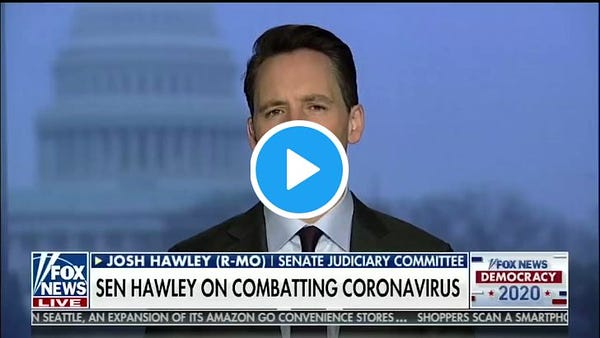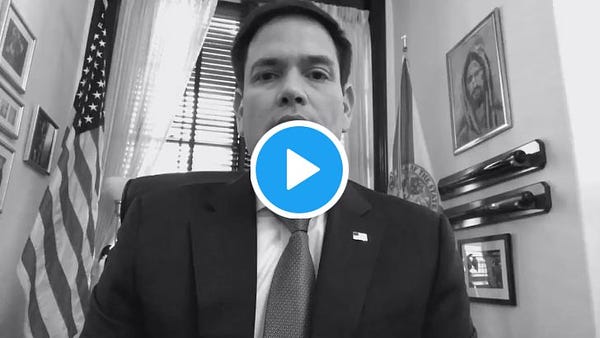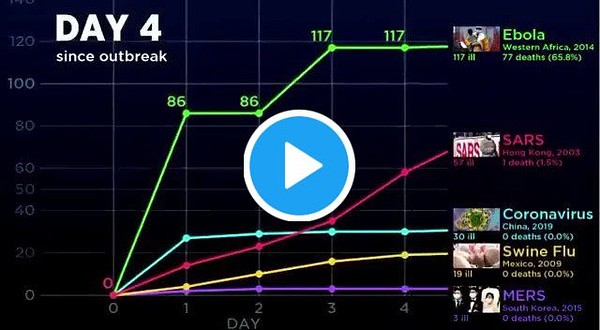Tangle is an independent, ad-free, non-partisan politics newsletter that offers both sides of the biggest news stories every day. If you found this online or someone forwarded you this email, please consider supporting balanced, independent journalism by subscribing below:
Today’s read: 7 minutes.
The coronavirus gets real, a question about whether Warren “flip-flops,” and a devastating story about opioid overdoses in rural Tennessee.

Airmen assist one another in donning their personal protective equipment, while on-board an Air Force C-17 Globemaster III during transportation isolation system training at Joint Base Charleston, South Carolina. Engineered and implemented after the Ebola virus outbreak in 2014, the TIS is an enclosure the Department of Defense can use to safely transport patients with diseases like novel coronavirus. (U.S. Air Force photo by Senior Airman Cody R. Miller)
What D.C. is talking about.
The coronavirus. Last night, President Donald Trump held a news conference to try to calm the nerves of the American people. He played down the threat facing the United States and said the risk of being infected remained very low. He also put Vice President Mike Pence in charge of federal response efforts as lawmakers have ramped up the pressure on his administration for answers. In the last 24 hours, bipartisan groups of lawmakers said they would pursue funding beyond the $2.5 billion Trump proposed. “We’re very, very ready for this, for anything, whether it is going to be a breakout of larger proportions or whether or not we’re at that very low level,” Trump said. Earlier this week, Nancy Messonnier, director of CDC’s National Center for Immunization and Respiratory Diseases, issued a less comforting take. “As we’ve seen from recent countries with community spread, when it has hit those countries, it has moved quite rapidly. We want to make sure the American public is prepared,” she said. “It’s not so much of a question of if this will happen anymore but rather more of a question of exactly when this will happen… Disruption to everyday life might be severe.” U.S. cities have started preparing for outbreaks. Then, last night, California reported the first possible case of the “community spread” that Messonnier warned about. That means a patient was infected who had not been to China or any of the countries fighting the virus, hadn’t been to a hospital where people were infected, and had not been knowingly exposed to the virus. In other words: they were likely infected by someone who doesn’t know they have the virus or in an area where we don’t know the virus is present, indicating the virus is “out.” If confirmed, it’s the first infection of its kind in the U.S., and we’ve seen in other countries that the virus spreads quickly after community transmissions begin.
What the left is saying.
This is supposed to be comforting? Mike Pence, the guy who questions evolution and once said cigarettes don’t kill people, is in charge? The reality is the Trump administration has spent the last two years cutting funding for the CDC, firing leaders in the government in control of things like this, and now has absolutely no plan on how to handle it. “Trump dismantled the epidemic-fighting infrastructure the Obama administration had built up at the National Security Council and the Department of Homeland Security,” Max Boot wrote in The Washington Post. During testimony to Congress earlier this week, the acting secretary of the Department of Homeland Security, Chad Wolff, testified and seemed to know very little about the virus. Even Trump allies like Republican Sen. John Kennedy slammed Wolff, becoming “visibly irate” and insisting he should have answers that he did not have. Trump is telling everyone to chill while experts say a pandemic is coming. All this really seems to be about is the president’s concern that the markets are tanking on news of the virus.



What the right is saying.
Thank God we don’t have Medicare-for-all. A lot of conservatives are noting how the private sector is flexing its muscles to respond to the virus right now. The drug company Moderna has already entered human testing for a vaccine, and the only thing that’s going to slow it down is the FDA’s stringent policies on approval. Several conservatives have used this moment to point to Bernie Sanders and note that the well-funded, wide-reaching U.S. pharmacy industry so often villainized is now the one the entire world is looking to for a cure and vaccine. “Medicare for All would smother the public-private infrastructure in the U.S. that develops, manufactures and distributes life-saving therapies for viruses—or anything else,” Dan Henniger wrote in the Wall Street Journal. Allies of Trump are pointing out that a few weeks ago, he was criticized mightily for ordering a quarantine and major travel restrictions for people coming from China. He barred all non-U.S. citizens who had recently visited China from entering. Now, that move looks a lot smarter as the virus tears through Europe and the Middle East, while remaining contained in the U.S.






My take.
I’d be lying if I told you I felt comfortable or confident. However you feel about Trump, there’s no doubt about the basic facts of this situation: the infrastructure responsible for responding to these kinds of outbreaks has taken a hit under his leadership. Many of the leadership positions in departments like Homeland Security are being held by acting secretaries (i.e. what’s supposed to be a temporary post), not people who were Senate approved. And the funding that would be responsible for handling this stuff was low enough that the administration suggested transferring $37 million to the response from the Low Income Home Energy Assistance Program. And yet — he does deserve some credit. The travel bans and quarantine restrictions may have at least slowed all this down. The administration is also doing what it can to fast track drug approval and vaccines to address it. Much like the Soleimani strike or the embassy move in Israel, it’d be stupid to call balls and strikes right now — the jury is still out. But there are absolutely political ramifications here. How the administration handles it, who takes the blame if things go south and what our government does to contain this has the potential to impact 2020 and Trump’s legacy.
When it comes to the virus, I’m not a medical expert and I’m not going to pretend to be one. But I can tell you a few things the experts know that I think are important. One, we know that we still don’t know much about the virus. The CDC believes it’s likely to spread quickly after community spread starts — and it sounds like that just happened in California. It’s also possible the virus remains contained for now and breaks out in a big way again next fall. For folks comparing it to the flu (even I did this early on), there are reasonable comparisons and unreasonable ones. Yes, the flu is still more of a threat just because of its prevalence. But the estimates we have for the death rate on coronavirus are about two percent. The flu is .1%. That’s means coronavirus is 20 times deadlier — and though two percent sounds low, as The New York Times noted, if 300 people you know get infected, and two percent die, that’s six people. This is a serious threat. So far, children seem the least likely to get the virus, something health officials can’t adequately explain. Older people and folks with immune system disorders seem the most likely to die from the virus.
As for prevention, we’re in it together. Information about how to slow the spread is available on CDC’s website or local health sites. Those websites universally suggest washing your hands often (20 seconds hot water and with soap), avoiding touching your nose and mouth, avoiding public places or the doctor’s offices if you can, and not assuming people of Asian descent have the virus. Symptoms are fever, cough, difficulty breathing or severe illness. If you have traveled to mainland China and have any of these symptoms, seek help right away. There’s also planning: there’s a good chance certain supply chains for common medicines will be impacted. If you take medication, it’d be wise to call your doctor and stock up for an extra month or two. Consider plans for working remotely, attending school remotely, etc. if at all possible. With any luck, in a few months, we’ll be talking about how that damn liberal media and Tangle were over-hyping this thing. But an abundance of caution and preparation will be the best way to make this an over-hyped media frenzy and not a full-blown health crisis.


Your questions, answered.
Reminder: Tangle is all about reader questions. To ask something, all you have to do is reply to this email and write in. Today, Tangle received two similar questions — so I am going to try to tackle them both together.
Q: There was a point in the debate when a moderator questioned Warren’s shifting health care strategy as a question in her policy consistency. She was previously aligned with Sanders’ plan and since pivoting she appears to align more closely with moderates in favor of a more transitional approach. Am I understanding that correctly and if so what changes has she incorporated and what larger significance does that have to her campaign trail? And more broadly, what is the chance of any change to the health care status quo actually being made during a more progressive electorate’s first term?
- Marcus, Pittsburgh, PA.
Q: I’m wondering if you have any insight as to whether Warren has changed her stance on issues with the aim of aligning with whatever is popular at the moment, more so than a regular politician already does. Or is this just “Bernie Bros” trying to finds reasons to hate her? I’m guessing that the truth is somewhere in the middle? I did some quick Googling and it’s difficult to find anything that looks objective.
- Taylor, Denver, CO.
Tangle: The short answer to both of you here is yes, Warren’s plans have changed and there is a reasonable critique of her on “policy consistency,” if that’s something that matters a lot to you as a voter. She has absolutely shifted to a less polarizing stance on Medicare-for-all, a pivot that appeared to begin in November. She hasn’t abandoned the policy, but the general contours of her “change” are that she extended the period of time that it would take to integrate Medicare-for-all. After initially backing Bernie’s plan, she instead released a proposal that would adopt a public option — much like the moderates in the race — and focus on “reversing Trump’s sabotage of the Affordable Care Act” and lowering the age to qualify for Medicare during her first term. Unlike Sanders’ plan, Warren’s would not force anyone to enroll in Medicare-for-all but instead it would make it so far more people were allowed to enroll in Medicare-for-all.
Warren’s plan is still quite radical though, and it could amount to the most complete overhaul of our health care system in American history. She seemed to suffer politically for it, taking on heat from the Sanders wing for bailing under the pressure and taking heat from the moderate wing for not having consistent policies. As for whether this kind of legislation could pass — it’s tough to imagine. There are all sorts of levers she could pull to implement parts of the policy piecemeal, but even if Democrats had a 60-seat majority in the Senate (which is unlikely) she’d still struggle to get enough on board to implement this how she wants. There’s talk of abolishing the Senate filibuster, which could open the door for passing legislation like this with a simple majority, but again — there are enough moderate Democrats that I don’t really see anyway a comprehensive Medicare-for-all bill is passed in the Senate anytime in the next 10 years. Then again, Sanders and Warren have plenty of historical evidence that a mass movement of populist political pressure could move the needle and make something like this possible.
More generally, and to Taylor’s question, I think there is some legitimacy to Warren’s “political opportunism.” I’ll note, though, that such derisive language is a framing of political evolution that I don’t think is fair. Like I’ve written before, most people view Bernie Sanders favorably because he’s been saying the same thing for 40 years. To me, that’s not a virtue. The world has changed a lot in 40 years, as have the best solutions, and I don’t necessarily think a politician who has the same answers now as they did two years or five years or fifty years ago is a good thing.
In its endorsement of Warren this week, The Boston Globe made this point in a way I wholeheartedly agree with. I’m not sure I could write it better myself so you can read the relevant section here:
“Warren is at her best when she is responsive to where voters are on policy prescriptions. While altering past positions is often criticized in political candidates, flexibility is her comparative virtue. Unlike Senator Sanders, whose ideological adherence to his agenda often flies in the face of facts and evades precise figures, Senator Warren is willing to adapt to changing circumstances and political concerns. She has, for example, backed away from an instant transition to a single-payer health care system. She voted in support of the recent US-Mexico-Canada trade deal, a pivot from her purist objections to the Trans-Pacific Partnership. Where others may see weakness, this board sees strength in her instances of nimbleness, and a reflection of her longstanding penchant for evidence as a driver of policy decisions. It hints at what is hopefully a willingness to compromise to accomplish real results when intransigence would sabotage a broader agenda.”
For what it’s worth, a year ago The Boston Globe was urging Warren not to run. They acknowledged their about-face and credited her campaign — and all of these qualities — as the reason they went from “don’t run” to endorsing her.
Basically: yes, Warren has changed her position on Medicare-for-all. And yes, she has shifted her policy positions (or “softened”) in the past. Some view this negatively as examples of politicial expediency or opportunism. There’s no doubt some of that is at play, and there’s also something to be said for folks like Bernie Sanders who lead the way on issues — i.e. take “radical” stances until the rest of the world catches up. But most of Warren’s policy shifts, to me, have looked a lot more like political realism and pragmatism than political opportunism or expediency. Even when I don’t agree with her, which is plenty, I can at least say she has a strong, evidence-based reason for her positions.
A story that matters.
In Carter County, Tennessee, health officials are taking on a frightening strategy to address opioid addicton: teaching children how to use Narcan. The program educates children as young as 6 years old on how to deliver the nasal spray — which can reverse heroin and opioid overdoses — on someone who appears to be overdosing. “It’s just like a little squirt gun,” an instructor tells the kids. The children are then given zippered bags with doses of Narcan inside. Carter County is a rural community that has been devastated by the opioid crisis. Nationally, 400,000 Americans have died from opioid related overdoses. In Tennessee alone, 8.1 million painkiller prescriptions have been written. And in Carter County, with a tiny population of 56,000 people, 60 people have died of opioid overdoses since 2014 — and many more are battling addiction. The New York Times has the story here.
Numbers.
7x. The rate at which Facebook users 65 and over are more likely to post articles from fake news websites compared to users under the age of 29.
9. The number of superdelegates, of 93 interviewed, who said Bernie Sanders should become the nominee if he has a plurality of the earned delagates at the National Convention.
2.2%, 2.5% and 2.9%. The percentage drop in the Dow Jones Industrial Average, S&P 500 and the Nasdaq Composite this morning as fears overs the economic impact of the coronavirus spread.
42%. The obesity rate for U.S. adults, according to a new CDC survey.
1 in 100. The number of American adults who were severely obese 50 years ago.
1 in 10. The number of American adults who are severely obese today.
29. The number of House seats Democrats won in 2018 that were in districts President Trump won in 2016.
5. The number of people killed in a Milwaukee brewery shooting yesterday, a tragedy that could re-ignite the gun control debate in the critical swing state of Wisconsin.
Enjoying Tangle?
Forward this email to 10 friends. They can subscribe with the button at the top (or the one below) — that’s the best way to spread the word about Tangle and bring people into the conversation.
Have a nice day.
For the first time, wind surpassed hydro as the most-used renewable form of electricity generation in the U.S. Solar power remained in third place among renewable electricity providers. 60,000 wind turbines in 41 states power what is equivalent to 32 million homes, and demand for windy energy is “greater than ever as evidenced by corporations and utilities signing contracts in record numbers,” according to American Wind Energy Association (AWEA) CEO Tom Kiernan. “Nearly 200 projects are underway in 33 states from the wind belt in America’s heartland to the booming offshore wind market, where visionary leaders are leveraging the affordable, clean energy that wind provides.” Click.



